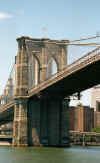 |
New York
Architecture Images- New York Bridges Brooklyn Bridge
Click here for
Brooklyn Bridge gallery 1 |
||||||||||||||||||||||||||||
| Contemporary black and white images on this page copyright Dave Frieder ( www.davefrieder.com ). Special thanks to Dave Frieder for permission to use images. | |||||||||||||||||||||||||||||
|
architect |
John Augustus Roebling, completed by son, Washington Augustus Roebling | ||||||||||||||||||||||||||||
|
location |
East River. Park Row, Manhattan to Adams Street, Brooklyn. | ||||||||||||||||||||||||||||
|
date |
1869 to 1883 | ||||||||||||||||||||||||||||
|
style |
Gothic piers, Structural Expressionist cables and bridge deck | ||||||||||||||||||||||||||||
|
construction |
steel cable, stone masonry piers | ||||||||||||||||||||||||||||
|
type |
suspension Bridge | ||||||||||||||||||||||||||||
|
data |
|
||||||||||||||||||||||||||||
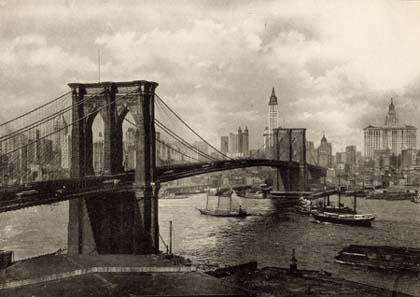 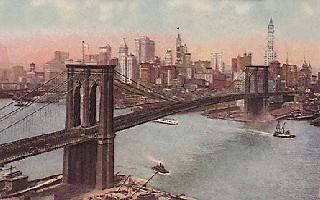 |
|||||||||||||||||||||||||||||
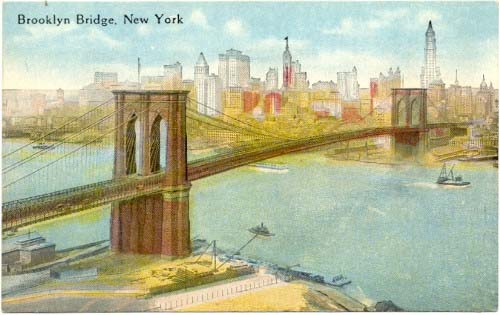 |
|||||||||||||||||||||||||||||
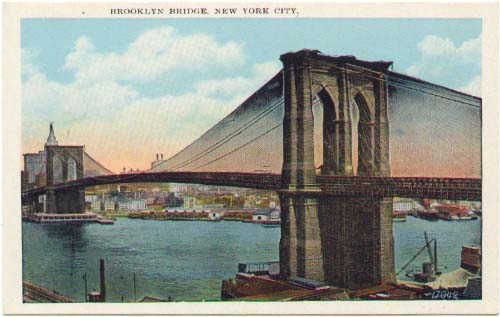 |
|||||||||||||||||||||||||||||
| Dave Frieder Gallery. Copyright Dave Frieder ( www.davefrieder.com ) | |||||||||||||||||||||||||||||
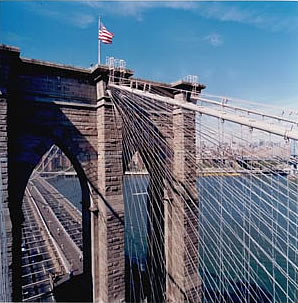
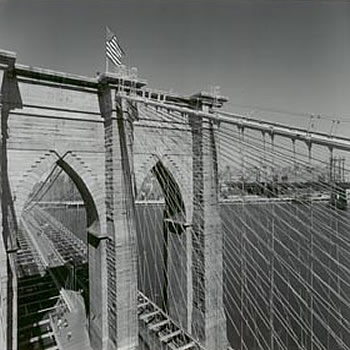 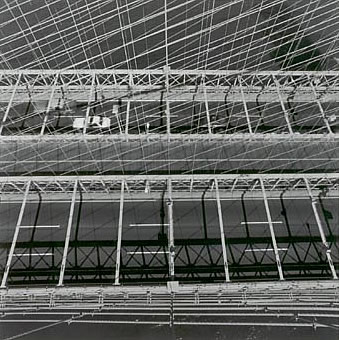
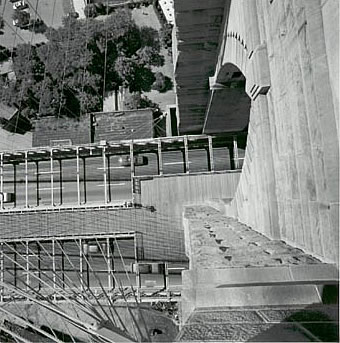
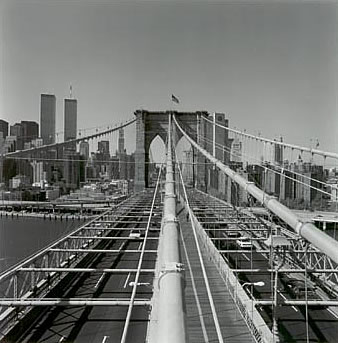 |
|||||||||||||||||||||||||||||
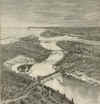   |
|||||||||||||||||||||||||||||
       |
|||||||||||||||||||||||||||||
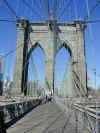 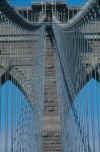 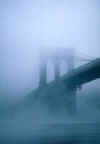  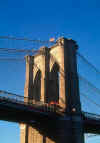 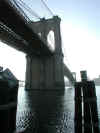  |
|||||||||||||||||||||||||||||
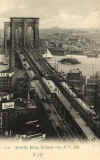 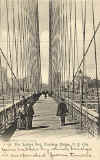 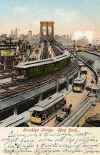 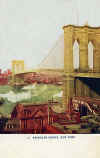    |
|||||||||||||||||||||||||||||
       |
|||||||||||||||||||||||||||||
 |
|||||||||||||||||||||||||||||
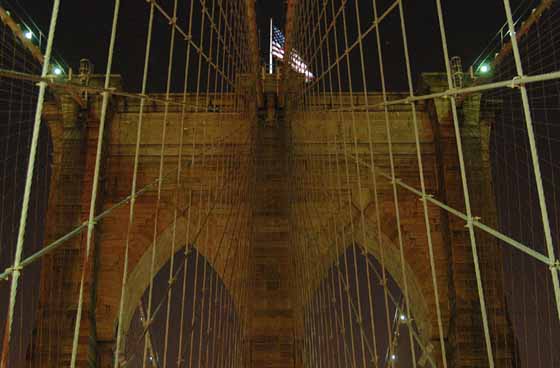 |
|||||||||||||||||||||||||||||
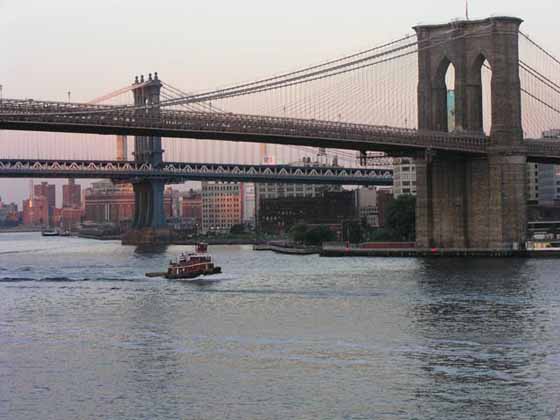 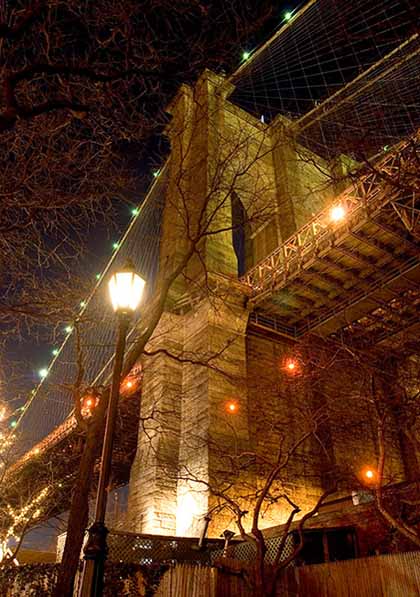 |
|||||||||||||||||||||||||||||
|
|
 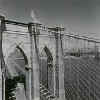    |
||||||||||||||||||||||||||||
|
images |
 |
||||||||||||||||||||||||||||
|
|
 |
||||||||||||||||||||||||||||
|
Architects: John A. and
Washington Roebling Brooklyn Bridge Commentary —Kenneth Frampton and Yukio Futagawa. Modern Architecture 1851-1945. p31. A VISION FOR A BRIDGE: Plans for a crossing between the city of Brooklyn and lower Manhattan dated back to the early 1800's. When the East River crossing was planned, Brooklyn, with about 400,000 residents, was still more rural than urban. The city of New York - which at the time consisted only of Manhattan - had twice as many residents, and the bridge was seen as a solution to overcrowding in Manhattan while spurring development in Brooklyn. The bridge would enable people and goods to cross the East River quickly, regardless of weather conditions. From The Great Bridge by David McCullough: A bridge over the East River, joining the cities of New York and Brooklyn, had been talked about for nearly as long as anyone can remember… But nothing was done. The chief problem was always the East River, which is no river at all technically speaking, but a tidal strait and one of the most turbulent and in that day, especially, one of the busiest stretches of navigable salt water anywhere on earth. "If there is to be a bridge," wrote one man, "it must take one grand flying leap from shore to shore over the masts of the ships. There can be no piers or drawbridge. There must be only one great arch all the way across. Surely this must be a wonderful bridge." In 1855, John Roebling, the owner of a wire-rope company and a famous bridge designer, proposed a suspension bridge over the East River after becoming impatient with the Atlantic Avenue-Fulton Street Ferry. Roebling worked out every detail of the bridge, from its massive granite towers to its four steel cables. He thought his design entitled the bridge "to be ranked as a national monument… a great work of art." The elder Roebling had experience with suspension spans, with bridges along the Delaware, Niagara and Ohio Rivers. The first of these, the Delaware Aqueduct (1848) between Lackawwaxen, Pennsylvania and Minisink Ford, New York, is the oldest surviving suspension bridge in America. The second, the Niagara Suspension Bridge (1855), served rail and carriage traffic until it was replaced with a stronger steel-arch bridge in 1891. The third, the Cincinnati-Covington Bridge (1867), was significantly strengthened in the 1890's with the addition of a steel deck truss, and remains in service today. Initially, Roebling was met with cool reception by the city governments of New York and Brooklyn. He then approached William C. Kingsley, a Brooklyn businessman with political connections and publisher of the influential Brooklyn Eagle, who met the idea with enthusiasm. In turn, Kingsley enlisted the support of Henry Murphy, a state senator and former mayor of Brooklyn. Murphy then drafted a bill to the New York State Legislature that would enable a private company to build a bridge connecting Manhattan and Brooklyn. In 1867, a group of prominent leaders formed the New York Bridge Company "for the purpose of constructing and maintaining a bridge across the East River." Under the enabling act, the city of Brooklyn (which stood to benefit the most from the bridge) subscribed for $3 million of the capital stock, while the city of New York only subscribed for $1.5 million. The company was permitted to fix toll rates for pedestrians and all types of vehicles, receiving a profit of no more than 15 percent per year. Responding to those who doubted the need for the bridge, Roebling responded that projected growth in the cities of New York and Brooklyn would necessitate the construction of additional bridges. Specifically, Roebling suggested future construction of the Williamsburg and Queensboro bridges further north along the East River. Two years later, in June 1869, the New York City Council and the Army Corps of Engineers approved Roebling's design. Later that month, while examining locations for a Brooklyn tower site, Roebling's foot was crushed on a pier by an incoming ferry. Roebling later died of tetanus as a result of the injuries. Immediately following Roebling's death, his son, Washington, took over as chief engineer of the Brooklyn Bridge. DEEP AND DARK UNDER
THE EAST RIVER: Soon after ground was broken on
January 3, 1870, work on the Manhattan and Brooklyn foundations. The
3,000-ton pneumatic caissons - large, airtight cylinders in which
workers cleared away layers of silt in an atmosphere of compressed air
underneath the riverbed - were dug 78½ feet below the river on the
Manhattan side, and 44½ feet below the river on the Brooklyn side. To
expedite the descent of the caissons, dynamite was used for the first
time in bridge construction. The foundations took three years to
construct.
|
|||||||||||||||||||||||||||||
|
The Brooklyn Bridge, one of the oldest suspension bridges in the United
States, stretches 5,989 feet (1825 m)[1] over the East River connecting
the New York City boroughs of Manhattan and Brooklyn. On completion, it
was the largest suspension bridge in the world and the first steel-wire
suspension bridge. Originally referred to as the New York and Brooklyn
Bridge, it was dubbed the Brooklyn Bridge in an 1867 letter to the
editor of the Brooklyn Daily Eagle,[2] and formally so named by the city
government in 1915. Since its opening, it has become an iconic part of
the New York skyline. In 1964 it was designated a National Historic
Landmark. History Construction The Brooklyn Bridge was completed thirteen years later and was opened for use on May 24, 1883. On that first day, a total of 1,800 vehicles and 150,300 people crossed. The bridge's main span over the East River is 1,595 feet 6 inches (486.3 m). The bridge cost $15.1 million to build and approximately 27 people died during its construction. A week after the opening, on May 30, a rumor that the Bridge was going to break down caused a stampede which crushed and killed twelve people.[6] At the time it opened, it was the longest suspension bridge in the world — 50% longer than any previously built — and it has become a treasured landmark. Additionally, for several years the towers were the tallest structures in the Western Hemisphere. Since the 1980s, it has been floodlit at night to highlight its architectural features. The bridge is built from limestone, granite, and Rosendale cement. The architectural style is Gothic, with characteristic pointed arches above the passageways through the stone towers. The bridge was designed by John Augustus Roebling in Trenton, New Jersey. Roebling had earlier designed and constructed other suspension bridges, such as Roebling's Delaware Aqueduct in Lackawaxen, Pennsylvania, the John A. Roebling Suspension Bridge in Cincinnati, Ohio and the Waco Suspension Bridge in Waco, Texas, that served as the engineering prototypes for the final design. During surveying for the East River Bridge project, Roebling's foot was badly injured by a ferry, pinning it against a pylon; within a few weeks, he died of tetanus. His son, Washington, succeeded him, but in 1872 was stricken with caisson disease (decompression sickness, commonly known as "the bends"), due to working in compressed air in caissons. The occurrence of the disease in the caisson workers caused him to halt construction of the Manhattan side of the tower 30 feet (10 m) short of bedrock when soil tests underneath the caisson found bedrock to be even deeper than expected. Today, the Manhattan tower rests only on sand. [7] Washington's wife, Emily Warren Roebling, became his aide, learning engineering and communicating his wishes to the on-site assistants. When the bridge opened, she was the first person to cross it. Washington Roebling rarely visited the site again. At the time the bridge was built, the aerodynamics of bridge building had not been worked out. Bridges were not tested in wind tunnels until the 1950s — well after the collapse of the Tacoma Narrows Bridge in 1940. It is therefore fortunate that the open truss structure supporting the deck is by its nature less subject to aerodynamic problems. Roebling designed a bridge and truss system that was six times as strong as he thought it needed to be. Because of this, the Brooklyn Bridge is still standing when many of the bridges built around the same time have vanished into history and been replaced. This is also in spite of the substitution of inferior quality wire in the cabling supplied by the contractor J. Lloyd Haigh — by the time it was discovered, it was too late to replace the cabling that had already been constructed. Roebling determined that the poorer wire would leave the bridge four rather than six times as strong as necessary, so it was eventually allowed to stand, with the addition of 250 cables. Diagonal cables were installed from the towers to the deck, intended to stiffen the bridge. This turned out to be unnecessary, but they are kept for their distinctive beauty. After the collapse of the I-35W highway bridge in the city of Minneapolis, increased public attention has been brought to bear on the condition of bridges across the US, and it has been reported that the some of the Brooklyn Bridge approach ramps received a rating of "poor" at its last inspection [8]. According to a NYC Department of Transportation spokesman, "The poor rating it received does not mean it is unsafe. Poor means there are some components that have to be rehabilitated.” A 725 million dollar project to replace the approaches and repaint the bridge is scheduled to begin in 2009.[9] Later changes in use At various times, the bridge has carried horses and trolley traffic; at present, it has six lanes for motor vehicles, with a separate walkway along the centerline for pedestrians and bicycles. Due to the roadway's height (11 feet posted) and weight (6,000 lb posted) restrictions, commercial vehicles and buses are prohibited from using this bridge. The two inside traffic lanes once carried elevated trains of the BMT from Brooklyn points to a terminal at Park Row. Streetcars ran on what are now the two center lanes (shared with other traffic) until the elevated lines stopped using the bridge in 1944, when they moved to the protected center tracks. In 1950 the streetcars also stopped running, and the bridge was rebuilt to carry six lanes of automobile traffic. 1994 Brooklyn Bridge Shooting On March 1, 1994, Lebanese-born Rashid Baz opened fire on a van carrying members of the Chabad-Lubavitch Orthodox Jewish Movement, striking 16 year old student Ari Halberstam and three others traveling on the bridge. Halberstam died five days later from his wounds. Baz was apparently acting out of revenge for the Hebron massacre of 29 Muslims by Baruch Goldstein that had taken place days earlier on February 25, 1994. Baz was convicted of murder and sentenced to a 141 year prison term. After initially classifying the murder as one committed out of road rage, the FBI reclassified the case in 2000 as a terrorist attack. The entrance ramp to the bridge on the Manhattan side was named the Ari Halberstam Memorial Ramp in memory of the victim[10]. 2003 Plot In 2003, truck driver Iyman Faris was sentenced to 20 years in prison for providing material support to al-Qaeda, after an earlier plot to destroy the bridge by cutting through its support wires with blowtorches was cancelled.[citation needed] 2006 Bunker Discovery In 2006, a Cold War era bunker was found by city workers near the East River shoreline of Manhattan's Lower East Side. The bunker, hidden within one of the masonry towers, still contains the emergency supplies that were being stored for a potential nuclear attack from the Soviet Union[11]. Access points Brooklyn Bridge shot from Fulton ParkThe Brooklyn Bridge is accessible from the Brooklyn entrances of Tillary/Adams Streets, Sands/Pearl Streets, and Exit 28B of the eastbound Brooklyn-Queens Expressway. In Manhattan, motor cars can enter from either direction of the FDR Drive, Park Row, Chambers/Centre Streets, and Pearl/Frankfort Streets. Pedestrian access to the bridge from the Brooklyn side is from either Tillary/Adams Streets (in between the auto entrance/exit), or a staircase on Prospect St between Cadman Plaza East and West. In Manhattan, the pedestrian walkway is accessible from the end of Centre Street, or through the unpaid south staircase of Brooklyn Bridge-City Hall IRT subway station. Trivia The three bridges that span the East River and connect Manhattan to Brooklyn are arranged, from South to North, according to the mnemonic BMW: the Brooklyn Bridge, the Manhattan Bridge and the Williamsburg Bridge. The BMT bridge tracks were planned to connect to what is now the Nassau Street Line subway at Chambers Street to form part of the never-finished Centre Street Loop. On March 24, 1983 the bridge was designated a National Historic Engineering Landmark. The construction of the Brooklyn Bridge is detailed in the 1972 book The Great Bridge by David McCullough and in the first PBS documentary film ever made by Ken Burns, Brooklyn Bridge (1980). Burns drew heavily on McCullough's book for the film and used him as narrator. The first person to jump from the bridge was Robert E. Odlum on July 23, 1886. Robert, a swimming teacher, made the jump in a costume bearing his initials. He survived the pre-announced jump, but died shortly thereafter from internal injuries.[12] Pedestrian access The Brooklyn Bridge has a wide pedestrian walkway open to walkers and cyclists, in the center of the bridge and higher than the automobile lanes. While the bridge has always permitted the passage of pedestrians across its span, its role in allowing thousands to cross takes on a special importance in times of difficulty when usual means of crossing the East River have become unavailable. During transit strikes by the Transport Workers Union in 1980 and 2005 the bridge was used by people commuting to work, with Mayors Koch and Bloomberg crossing the bridge as a gesture to the affected public. Following the 1965, 1977 and 2003 Blackouts and most famously after the September 11, 2001 attacks on the World Trade Center, the bridge was used by people in Manhattan to leave the city after subway service was suspended. The massive numbers of people on the bridge could not have been anticipated by the original designer, and yet John Roebling designed it with three separate systems managing even unanticipated structural stresses. The bridge has a suspension system, a diagonal stay system, and a stiffening truss. "Roebling himself famously said if anything happens to one of [his] systems, 'The bridge may sag, but it will not fall.'"[13] The movement of large numbers of people creates pedestrian oscillations or "sway" as the crowd lifts one foot after another, some falling inevitably in synchronized cadences. The natural sway motion of people walking caused small sideways oscillations in the bridge, which in turn cause people on the bridge to sway in step, increasing the amplitude of the bridge oscillations and continually reinforcing the effect. This high-density traffic causes the bridge to appear to move erratically or "to wobble" as happened at opening of the London Millennium Footbridge in 2000.[14] Cultural significance Contemporaries marveled at what technology was capable of and the bridge became a symbol of the optimism of the time. John Perry Barlow wrote in the late 20th century of the "literal and genuinely religious leap of faith" embodied in the Brooklyn Bridge … the Brooklyn Bridge required of its builders faith in their ability to control technology."[15] References to "selling the Brooklyn Bridge" abound in American culture, sometimes as examples of rural gullibility but more often in connection with an idea that strains credulity. For example, "If you believe that, I have a wonderful bargain for you…" References are often nowadays more oblique, such as "I could sell you some lovely riverside property in Brooklyn ... ". George C. Parker and William McCloundy are two early 20th-century con-men who had (allegedly) successfully perpetrated this scam on unwitting tourists.[2] In his second book The Bridge, Hart Crane begins with a poem entitled "Poem: To Brooklyn Bridge." The bridge was a source of inspiration for Crane and he owned different apartments specifically to have different views of the bridge. Kurt Vonnegut references the sale of the Brooklyn Bridge in his 1987 novel Bluebeard. "If I had taken his money, it would have been like selling him Brooklyn Bridge." Film The Bugs Bunny cartoon "Bowery Bugs" "explains" the legend of why Steve Brodie jumped from the bridge, and ends with Bugs closing a sale of the bridge to the person to whom he has narrated the story. Although Steve Brodie was a real saloon owner operating near the bridge, his 1886 leap is widely believed to be a self-promoting myth. In the 1982 film Sophie's Choice, writer Nathan Landau (played by Kevin Kline) stands on the bridge with his lover Sophie (Meryl Streep) and his protégé Stingo (Peter MacNicol) evoking the names of great Brooklyn writers such as Herman Melville and Hart Crane. In Disney's 1988 film Oliver & Company, the Brooklyn Bridge is depicted having subway railroads. It was first shown when the villain Sykes goes after Fagin, Jenny, and their pets. In the 1992 movie Newsies, Jack Kelly (Christian Bale) and Boots (Arvie Lowe Jr.) scream off the Brooklyn Bridge on their way to see Spot Conlon (Gabriel Damon) in Brooklyn. In the 1996 film If Lucy Fell, the two main characters plan to commit suicide by jumping off the Brooklyn Bridge if they have not found love by the time one of them turns 30 years old. In the 1996 film Independence Day, the Brooklyn Bridge and the Manhattan Bridge are seen as an alien space ship passes over them and appears over New York City, which it later destroys In the 1998 American version of Godzilla, Godzilla runs across the bridge, toppling one of the towers and ending up tangled in the suspension cables. In the 1998 film Deep Impact, a tsunami caused by a comet crashing into the Atlantic Ocean destroyed the bridge. The Brooklyn Bridge is featured at the end of Martin Scorsese's Gangs of New York, in the 1973 James Bond film Live and Let Die, and in the 2004 film Team America: World Police. The DVD cover for the 1998 film The Siege shows an image of the Brooklyn Bridge being destroyed in a terrorist attack. In the film this attack is not shown, although the bridge is used as an escape from Manhattan during terrorist attacks. The movie Virginal Young Blondes (2004) also takes place on the Brooklyn Bridge, when the two main characters get stoned together in the movie's last scenes. In the 2001 movie Kate and Leopold, a time portal in the East River is accessed by jumping off the Brooklyn Bridge, so as to make use of the acceleration afforded by gravity. This time portal opens at certain intervals and, in this film, takes one back to 1876. In the fictional 2002 graffiti movie Bomb the System, we are led to believe that the main character's older brother died while painting the Brooklyn Bridge. Later in the film his older brother's best friend tells him that his older brother "never intended to come down from the bridge alive." Finally, after the main character's best friend dies, the main character climbs up and paints the side of the Brooklyn Bridge with the words "R.I.P. BUK 50." The bridge is prominently featured in the 2005 film Fantastic Four, starring Jessica Alba and Michael Chiklis. Scenes depicting the roadway of the bridge were actually filmed on a set in Vancouver, Canada using a green screen and CGI (Computer-generated imagery) technology. In the 2005 film Stay the bridge play a significant role in the ending of the movie. The 2006 movie Night at the Museum begins with an uncredited cameo of the bridge. In 2006's Superman Returns, the bridge is seen in several scenes, although the movie is set in the fictional city of Metropolis, rather than New York. In addition, Superman and Lois Lane fly parallel to the bridge. In 2007's I Am Legend, the Brooklyn and Manhattan Bridges were seen with their center spans destroyed when Robert visited the South Street Seaport. In a flashback, it is revealed that it was hit by missiles fired from jets to stop the KV virus from escaping a quarantined Manhattan. Some reports, including one in the Hollywood Reporter, claimed this was the most expensive scene (5 million dollars) to date in New York City, however the cost of the scene was disputed by the producer of the film in an interview.[16] Television A TV show called Brooklyn Bridge aired in prime time from 1991 through 1993 on CBS. An aerial view of the Brooklyn Bridge, in winter, with snow on the pedestrian path, is featured in the opening sequence to Law and Order SVU A dramatization of the challenges faced by the Roebling family during construction of the bridge are portrayed in the BBC documentary series Seven Wonders of the Industrial World. On The Fairly OddParents, a short scene of the world laughing at the end of the episode "Information Stupor Highway" shows New York City laughing with an animated Brooklyn Bridge. The span is seen in several episodes of The Cosby Show. The bridge is used in the season 3 opener of CSI: NY, "People with Money", where a young couple was murdered while allegedly "having sex". A woman in this episode was attacked by a keychain knife, leading the detectives to investigate the heinous crime. In the cartoon The Fairly OddParents, Cosmo tells Timmy that a man sold him the deed to the Brooklyn Bridge. The music video for Taking Back Sunday's "You're So Last Summer" features the bridge as a backdrop. In Aftershock: Earthquake in New York, the bridge is seen destroyed after an earthquake strikes New York City. In an episode of the NBC situation comedy Night Court, a man claims that the city of New York cashed his check for the Brooklyn Bridge, therefore he was the new rightful owner. The bridge appeared in three country music videos in 1994: "I'm Holding My Own" (Lee Roy Parnell), "The City Put The Country Back In Me" (Neil McCoy), and "When Love Finds You" (Vince Gill). The Bridge appeared in Lil' Kim "Lighters Up (Welcome to Brooklyn)" music video and Foxy Brown "BK Anthem". |
|||||||||||||||||||||||||||||